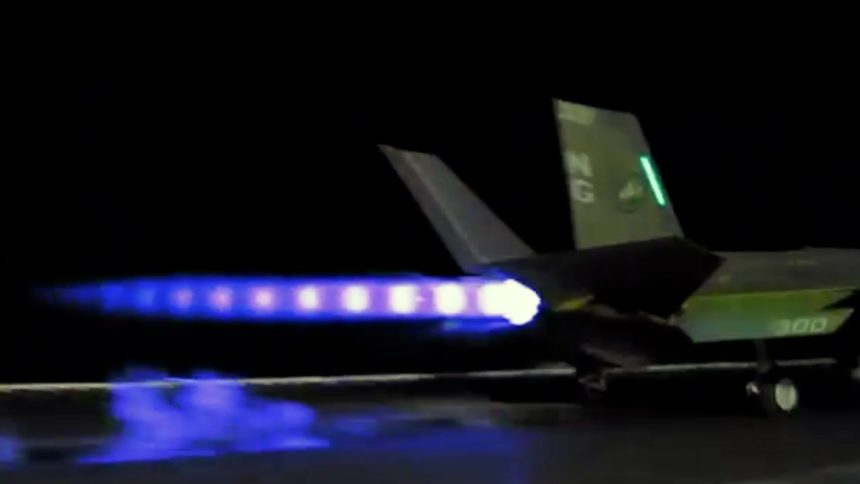Baptism of fire for the F-35C during U.S. operations targeting Houthi threats in the Red Sea and Gulf of Aden region.
F-35C deployed aboard USS Abraham Lincoln in the 5th Fleet AOR (Area Of Responsibility) were involved, along with other assets, in the latest series of air strikes against Houthi-controlled targets (weapon storage facilities) in Yemen. The operation, conducted between on Nov. 9 and 10, 2024, targeted multiple sites harboring advanced weaponry within Houthi-held regions. The operation aimed to neutralize the Houthi’s capacity to threaten U.S. and allied commercial and military vessels operating in critical maritime zones, including the Red Sea and the Gulf of Aden.
Aircraft from USS Abraham Lincoln (CVN 72) support operations against Iran-backed Houthis in the U.S. Central Command area of responsibility. pic.twitter.com/8Y4yqsAepd
— U.S. Central Command (@CENTCOM) November 12, 2024
During a press briefing at the Pentagon, U.S. DoD Press Secretary Maj. Gen. Pat Ryder said:
U.S. Central Command forces executed a series of precise airstrikes November 9 to 10 on multiple Houthi weapon storage facilities situated within Houthi controlled territories in Yemen. These facilities housed a variety of advanced conventional weapons used by the Iran-backed Houthis to target us and international military and civilian vessels navigating international waters in the Red Sea and Gulf of Aden.
The operation involved U.S Air Force and U.S. Navy assets to include F-35 sea fighter aircraft. This targeted operation was conducted in response to the Houthis repeated and unlawful attacks on international commercial shipping as well as us coalition and merchant vessels in the Red Sea, Bob Alde Strait and the Gulf of Aden. It also aimed to degrade the Houthis ability to threaten regional partners as you’ve heard us say before, we will continue to make clear to the Houthis that there will be consequences for their illegal and reckless attacks.
Although the Pentagon Press Secretary mentioned that U.S. Navy assets including the F-35 took part in the air strikes, the squadron deployed aboard USS Abraham Lincoln is a U.S Marine Corps unit: Marine Fighter Attack Squadron (VMFA) 314. Noteworthy, the air strikes in Yemen mark the baptism of fire for the Carrier Variant of the Lightning II, the last of the three models (A, B and C) to make its combat debut.
Six years ago, it was another U.S. Marine Corps squadron to carry out the first Joint Strike Fighter’s air strike: on Sept. 27, 2018, U.S. Marine Fighter Attack Squadron 211, the “Wake Island Avengers”, of the 13th Marine Expeditionary Unit, used their F-35B Lighting II aircraft to hit insurgent targets in Afghanistan’s Kandahar Province. The long-range strikes were launched from the U.S. Navy Wasp-class amphibious assault ship USS Essex (LHD-2) on station in the Persian Gulf.
The F-35A’s first combat employment came on Apr. 30, 2019, when two U.S. Air Force Lightning II belonging to the contingent from active duty 388th and reserve 419th Fighter Wings at Hill Air Force Base, Utah, deployed to Al Dhafra, UAE, conducted an air strike in support of Combined Joint Task Force – Operation Inherent Resolve using JDAMs (Joint Direct Attack Munitions) to strike “an entrenched Daesh tunnel network and weapons cache deep in the Hamrin Mountains, a location able to threaten friendly forces” in the Wadi Ashai area, in northern Iraq.
For the moment, CENTCOM has not released any additional detail about the F-35C’s first combat employment. The only video released so far just shows a VMFA-314’s Lightning II (with RCS enhancers) as well as unarmed EA-18G and F/A-18F launching at night.
Marine Fighter Attack Squadron (VMFA) 314
VMFA-314 was the first Marines squadron to replace the “Legacy” Hornet with the new F-35C. The transition began in 2019.
In total, the U.S Marine Corps currently has fourteen active F-35 squadrons. Twelve of these are equipped with the F-35B STOVL variant, with the remaining two, VMFA-314 and VMFA-311, operating the F-35C. VMFA-251 is set to stand up as an F-35C unit in 2025 and it has received its first Lightning II jet in September; VMFA-115 will follow by 2027. The F-35C variant is the CATOBAR variant, able to be launched from an aircraft carrier catapult and recovered with an arresting wire. These squadrons are the successors to USMC F/A-18C/D Hornet units which deploy alongside U.S. Navy squadrons on board the service’s nuclear-powered Nimitz class and Gerald R. Ford class aircraft carriers.
The USMC plans to operate the Hornet until 2030, but a number of squadrons have already been disbanded in order to convert to either F-35B or F-35C units.
Houthi claims
During the Press briefing, Press Secretary Maj. Gen. Pat Ryder also said that the U.S. Navy successfully repelled multiple Houthi attacks, carried out with at least three anti-ship cruise missiles, five anti-ship ballistic missiles, and eight one-way attack drones. All attacks were “successfully engaged and defeated,” with no damage to the vessels and no personnel injuries.
@PentagonPresSec Maj. Gen. Pat Ryder said Houthi fighters in Yemen launched attacks against two U.S. destroyers navigating the Bab-el Mandeb strait Monday. The USS Stockdale and USS Spruance “were attacked by at least eight one-way attack and two unmanned aerial systems, five…
— Tara Copp (@TaraCopp) November 12, 2024
Earlier, the Houthi had claimed they had hit USS Abraham Lincoln and two destroyers.
The Houthis are back in their Fantasyland, claiming this time to have “Successfully Targeted” both the USS Abraham Lincoln (CVN-72) in the Arabian Sea using Anti-Ship Cruise Missiles and Drones, as well as a Pair of Arleigh Burke-Class Guided-Missile Destroyers in the Red Sea… pic.twitter.com/QKNGrQ323F
— OSINTdefender (@sentdefender) November 12, 2024









